Paraguay
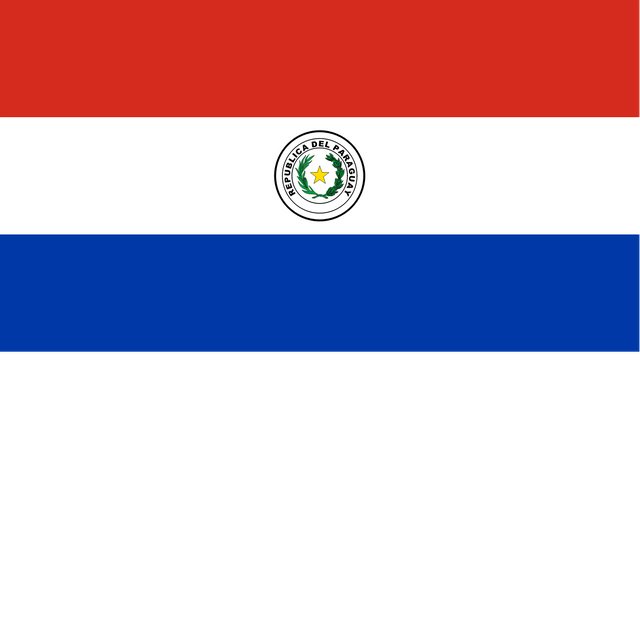
Paraguay

Republic of Paraguay
| |
|---|---|
Seal[1] | |
Motto:"Paz y justicia"(Spanish) "Peace and justice" | |
Anthem: Himno Nacional Paraguayo(Spanish) Paraguayan National Anthem | |
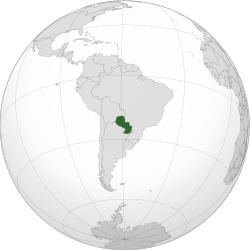 Location of Paraguay (dark green)in South America (grey) | |
 | |
| Capital and largest city | Asunción 25°16′S 57°40′W [124] |
| Official languages |
|
| Ethnic groups (2016[3]) |
|
| Religion (2017)[4] |
|
| Demonym(s) | Paraguayan Guaraní (colloquial)[5] |
| Government | Unitary dominant-party presidential republic |
• President | Mario Abdo Benítez |
• Vice President | Hugo Velázquez |
| Legislature | Congress |
• Upper house | Senate |
• Lower house | Chamber of Deputies |
| Independencefrom Spain | |
• Declared | 14 May 1811 |
• Recognized | 25 November 1842 |
• Admitted to the United Nations | 24 October 1945 |
| Area | |
• Total | 406,752 km2(157,048 sq mi) (59th) |
• Water (%) | 2.3 |
| Population | |
• 2019 estimate | 7,152,703[6] (104th) |
• Density | 17.58/km2(45.5/sq mi) (210th) |
| GDP(PPP) | 2019 estimate |
• Total | $101.075 billion[6] (88th) |
| GDP(nominal) | 2019 estimate |
• Total | $44.557 billion[6] (94th) |
• Per capita | $6,229[6] (94th) |
| Gini(2017) | high |
| HDI(2017) | high · 110th |
| Currency | Guaraní (PYG) |
| Time zone | UTC–4(PYT) |
• Summer (DST) | UTC–3(PYST) |
| Driving side | right |
| Calling code | +595 |
| ISO 3166 code | PY |
| Internet TLD | .py |
| |
Paraguay (/ˈpærəɡwaɪ/; Spanish pronunciation: [paɾaˈɣwaj] (listen); Guarani: Paraguái, [paɾaˈɰwaj]), officially the Republic of Paraguay (Spanish: República del Paraguay; Guarani: Tetã Paraguái), is a country in South America. It is bordered by Argentina to the south and southwest, Brazil to the east and northeast, and Bolivia to the northwest. Although it is one of only two landlocked countries in South America (the other is Bolivia), the country has coasts,[11] beaches[12] and ports on the Paraguay and Paraná rivers that give exit to the Atlantic Ocean through the Paraná-Paraguay Waterway.[13] Due to its central location in South America, it is sometimes referred to as Corazón de Sudamérica ("Heart of South America").[14]
Spanish conquistadores arrived in 1524 after navigating northwards from the Río de la Plata to the Paraná River, and finally up the Paraguay River. In 1537, they established the city of Asunción,[15] which was the first capital of the Governorate of Paraguay and Río de la Plata. Paraguay was the epicenter of the Jesuit Missions, where the Guaraní people were educated and introduced to Christianity and European culture under the direction of the Society of Jesus in Jesuit reductions, mainly during the 17th century.[16] However, after the expulsion of the Jesuits from Spanish territories in 1767, Paraguay increasingly became a peripheral colony, with few urban centers and settlers. Following independence from Spain at the beginning of the 19th century, Paraguay was ruled by a series of authoritarian governments who generally implemented nationalist, isolationist and protectionist policies. This period ended with the disastrous Paraguayan War, during which Paraguay lost at least 50% of its prewar population and around 25–33% of its territory to the Triple Alliance of Argentina, Brazil and Uruguay. In the 20th century, Paraguay faced another major international conflict – the Chaco War – against Bolivia, from which the Paraguayans emerged victorious. Afterwards, the country entered a period of military dictatorships, ending with the 35 year regime of Alfredo Stroessner that lasted until he was toppled in 1989 by an internal military coup. This marked the beginning of the "democratic era" of Paraguay.
With around seven million inhabitants, Paraguay is a founding member of Mercosur, an original member of the United Nations, the Organization of American States, the Non-Aligned Movement and the Lima Group. Also, the city of Luque, in Asuncion's Metropolitan Area, is the seat of the CONMEBOL. The Guarani culture is very influential and more than 90% of the people speak different forms of the Guarani language in addition to Spanish. Paraguayans are known for being a very happy and easy-living people and many times the country has topped the "world's happiest place" charts because of the "positive experiences" lived and expressed by the population.[17][18]
Republic of Paraguay
| |
|---|---|
Seal[1] | |
Motto:"Paz y justicia"(Spanish) "Peace and justice" | |
Anthem: Himno Nacional Paraguayo(Spanish) Paraguayan National Anthem | |
 Location of Paraguay (dark green)in South America (grey) | |
 | |
| Capital and largest city | Asunción 25°16′S 57°40′W [124] |
| Official languages |
|
| Ethnic groups (2016[3]) |
|
| Religion (2017)[4] |
|
| Demonym(s) | Paraguayan Guaraní (colloquial)[5] |
| Government | Unitary dominant-party presidential republic |
• President | Mario Abdo Benítez |
• Vice President | Hugo Velázquez |
| Legislature | Congress |
• Upper house | Senate |
• Lower house | Chamber of Deputies |
| Independencefrom Spain | |
• Declared | 14 May 1811 |
• Recognized | 25 November 1842 |
• Admitted to the United Nations | 24 October 1945 |
| Area | |
• Total | 406,752 km2(157,048 sq mi) (59th) |
• Water (%) | 2.3 |
| Population | |
• 2019 estimate | 7,152,703[6] (104th) |
• Density | 17.58/km2(45.5/sq mi) (210th) |
| GDP(PPP) | 2019 estimate |
• Total | $101.075 billion[6] (88th) |
| GDP(nominal) | 2019 estimate |
• Total | $44.557 billion[6] (94th) |
• Per capita | $6,229[6] (94th) |
| Gini(2017) | high |
| HDI(2017) | high · 110th |
| Currency | Guaraní (PYG) |
| Time zone | UTC–4(PYT) |
• Summer (DST) | UTC–3(PYST) |
| Driving side | right |
| Calling code | +595 |
| ISO 3166 code | PY |
| Internet TLD | .py |
| |
Etymology
The exact meaning of the word "Paraguay" is unknown, though it seems to derive from the river of the same name. One of the most common explanations is that it means "water of the Payagua (a native tribe)". Another meaning links the Guarani words para ("river") and guai ("crown"), meaning "crowned river". A third meaning may be para ("river"), gua ("from"), y ("water") meaning "water that comes from the river", referring to the bog in the north of the country, which is actually in Brazil.
History
Pre-Columbian era
The indigenous Guaraní had been living in eastern Paraguay for at least a millennium before the arrival of the Spanish. Western Paraguay, the Gran Chaco, was inhabited by nomads of whom the Guaycuru peoples were the most prominent. The Paraguay River was roughly the dividing line between the agricultural Guarani people to the east and the nomadic and semi-nomadic people to the west in the Gran Chaco. The Guarcuru nomads were known for their warrior traditions and were not fully pacified until the late 19th century. These indigenous tribes belonged to five distinct language families, which were the bases of their major divisions. Differing language speaking groups were generally competitive over resources and territories. They were further divided into tribes by speaking languages in branches of these families. Today 17 separate ethnolinguistic groups remain.
Colonization
The first Europeans in the area were Spanish explorers in 1516.[19] The Spanish explorer Juan de Salazar de Espinosa founded the settlement of Asunción on 15 August 1537. The city eventually became the center of a Spanish colonial province of Paraguay.
An attempt to create an autonomous Christian Indian nation[20] was undertaken by Jesuit missions and settlements in this part of South America in the eighteenth century, which included portions of Uruguay, Argentina, and Brazil. They developed Jesuit reductions to bring Guarani populations together at Spanish missions and protect them from virtual slavery by Spanish settlers and Portuguese slave raiders, the Bandeirantes, in addition to seeking their conversion to Christianity. Catholicism in Paraguay was influenced by the indigenous peoples; the syncretic religion has absorbed native elements. The reducciones flourished in eastern Paraguay for about 150 years, until the expulsion of the Jesuits by the Spanish Crown in 1767. The ruins of two 18th-century Jesuit Missions of La Santísima Trinidad de Paraná and Jesús de Tavarangue have been designated as World Heritage Sites by UNESCO.[20]
In western Paraguay, Spanish settlement and Christianity were strongly resisted by the nomadic Guaycuru and other nomads from the 16th century onward. Most of these peoples were absorbed into the mestizo population in the 18th and 19th centuries.
Independence and rule of Francia
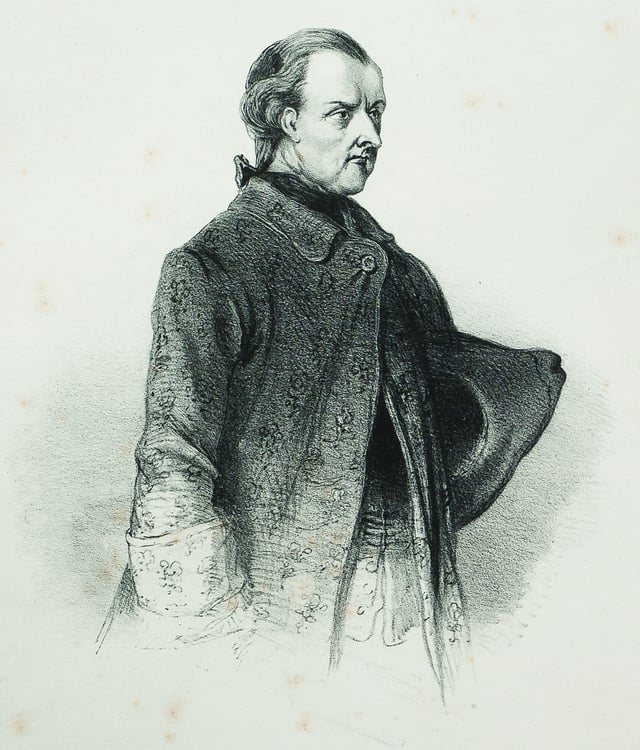
José Gaspar Rodríguez de Francia, Paraguay's first dictator.
Paraguay overthrew the local Spanish administration on 14 May 1811. Paraguay's first dictator was José Gaspar Rodríguez de Francia who ruled Paraguay from 1814 until his death in 1840, with very little outside contact or influence. He intended to create a utopian society based on the French theorist Jean-Jacques Rousseau's Social Contract.[21]
Rodríguez de Francia established new laws that greatly reduced the powers of the Catholic church (Catholicism was then an established state religion) and the cabinet, forbade colonial citizens from marrying one another and allowed them to marry only blacks, mulattoes or natives, in order to break the power of colonial-era elites and to create a mixed-race or mestizo society.[22] He cut off relations between Paraguay and the rest of South America. Because of Francia's restrictions of freedom, Fulgencio Yegros and several other Independence-era leaders in 1820 planned a coup d’état against Francia, who discovered the plot and had its leaders either executed or imprisoned for life.
Rule of the López family
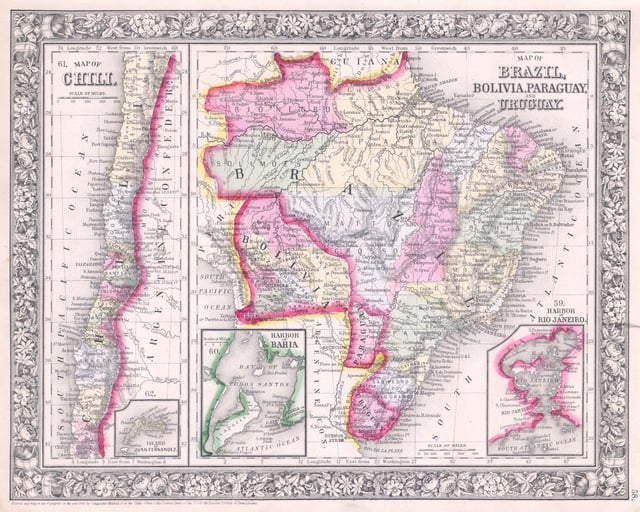
Political map of the region, 1864
After Francia's death in 1840, Paraguay was ruled by various military officers under a new junta, until Carlos Antonio López (allegedly Rodríguez de Francia's nephew) came to power in 1841. López modernized Paraguay and opened it to foreign commerce. He signed a non-aggression pact with Argentina and officially declared independence of Paraguay in 1842. After López's death in 1862, power was transferred to his eldest son, Francisco Solano López.
The regime of the López family was characterized by pervasive and rigid centralism in production and distribution. There was no distinction between the public and the private spheres, and the López family ruled the country as it would a large estate.[23]
The government exerted control on all exports. The export of yerba mate and valuable wood products maintained the balance of trade between Paraguay and the outside world.[24] The Paraguayan government was extremely protectionist, never accepted loans from abroad and levied high tariffs against imported foreign products. This protectionism made the society self-sufficient, and it also avoided the debt suffered by Argentina and Brazil. Slavery existed in Paraguay, although not in great numbers, until 1844, when it was legally abolished in the new constitution.[25]
Francisco Solano López, the son of Carlos Antonio López, replaced his father as the President-Dictator in 1862, and generally continued the political policies of his father. Both wanted to give an international image of Paraguay as "democratic and republican", but in fact, the ruling family had almost total control of all public life in the country, including church and colleges.[26]
Militarily, Carlos Antonio López modernized and expanded industry and the Paraguayan Army and greatly strengthened the strategic defenses of Paraguay by developing the Fortress of Humaitá.[27] The government hired more than 200 foreign technicians, who installed telegraph lines and railroads to aid the expanding steel, textile, paper and ink, naval construction, weapons and gunpowder industries. The Ybycuí foundry, completed in 1850, manufactured cannons, mortars and bullets of all calibers. River warships were built in the shipyards of Asunción. Fortifications were built, especially along the Apa River and in Gran Chaco.[28] [] The work was continued by his son Francisco Solano and in terms of socio-economic development, the country was dubbed as "the most advanced Republic in South America", notably by the British judge and politician Sir Robert Phillimore.[29]
According to George Thompson, Lieutenant Colonel of Engineers in the Paraguayan Army prior to and during the war, López's government was comparatively a good one for Paraguay:
Probably in no other country in the world has life and property been so secure as all over Paraguay during his (Antonio Lopez's) reign. Crime was almost unknown, and when committed, immediately detected and punished. The mass of the people was, perhaps, the happiest in existence. They had hardly to do any work to gain a livelihood. Each family had its house or hut in its own ground. They planted, in a few days, enough tobacco, maize and mandioca for their own consumption [...]. Having at every hut a grove of oranges [...] and also a few cows, they were almost throughout the year under little necessity [...]. The higher classes, of course, lived more in the European way...— George Thompson, C.E.[30]
Paraguayan War (1864–1870)
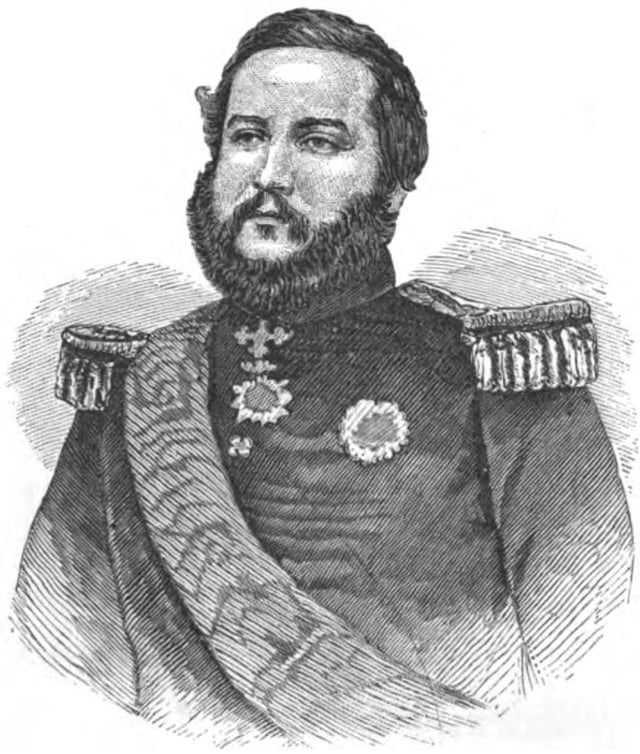
Francisco Solano López
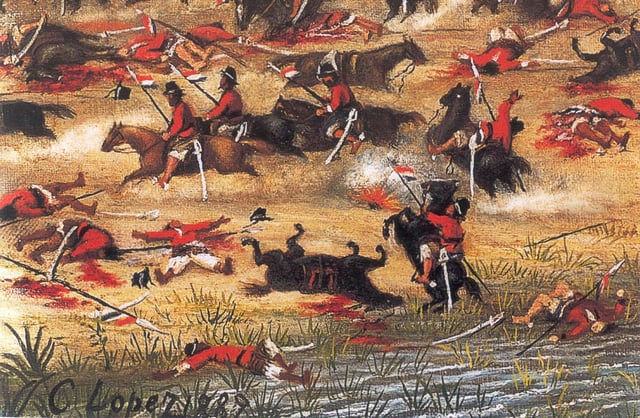
The Battle of Tuyutí, May 1866
On 12 October 1864, despite Paraguayan ultimatums, the Brazil (sided with the Argentine Government under General Bartolomé Mitre and the rebellious Uruguayan colorados led by Gen. Venancio Flores) invaded the Republic of Uruguay in order to overthrow the government of that time (which was under the rule of the Blanco Party, an ally of López)[31], thus starting the Paraguayan War.[32]
The Paraguayans, led by the Marshal of the Republic Francisco Solano López, retaliated by attacking the Matto Grosso on 15 December 1864 and later declared war against Argentina on 23 March 1865. The "Blanco Government" was toppled and replaced by a "Colorado Government" under General Venancio Flores on 22 February 1865 and afterwards, the Argentine Republic, the Empire of Brazil and the Republic of Uruguay signed the Secret Treaty of the Triple Alliance against the Paraguayan Government, on 1 May 1865.[33]
The Paraguayans held a ferocious resistance but were ultimately defeated in 1870 after the Battle of Cerro Corá, where Marshal Solano López was killed in action, refusing to surrender.[34] The real causes of this war, which remains the bloodiest international conflict in the history of The Americas, are still highly debated.[35]
Paraguay lost 25-33% of its territory to Argentina and Brazil, was forced to pay an enormous war debt and to sell large amounts of national properties in order to restore its internal budget. But the worst consequence of the war was the catastrophic loss of population. At least 50% of the Paraguayans died during the conflict and took long decades for the country to recover. About the disaster suffered by the Paraguayans at the outcome of the war, William D. Rubinstein wrote:
"The normal estimate is that of a Paraguayan population of somewhere between 450,000 and 900,000, only 220,000 survived the war, of whom only 28,000 were adult males."[36]
During the pillaging of Asunción in 1869, the Imperial Brazilian Army packed up and transported the Paraguayan National Archives to Rio de Janeiro.[37][38] Brazil's records from the war have remained classified.[39] This has made Paraguayan history in the Colonial and early National periods difficult to research and study.
20th century
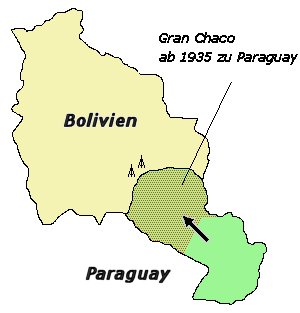
Gran Chaco was the site of the Chaco War (1932–35), in which Bolivia lost most of the disputed territory to Paraguay.

Paraguayan recruits during the Chaco war
In 1904 the Liberal revolution against the rule of Colorados broke out. The Liberal rule started a period of great political instability. Between 1904 and 1954 Paraguay had thirty-one presidents, most of whom were removed from office by force.[40] Conflicts between the factions of the ruling Liberal party led to the Paraguayan Civil War of 1922.
The unresolved border conflict with Bolivia over the Chaco region finally erupted in the early 1930s in the Chaco War. After great losses Paraguay defeated Bolivia and established its sovereignty over most of the disputed Chaco region. After the war, military officers used popular dissatisfaction with the Liberal politicians to seize the power for themselves. On 17 February 1936, the February Revolution brought colonel Rafael Franco to power. Between 1940 and 1948, the country was ruled by general Higinio Morínigo. Dissatisfaction with his rule resulted in the Paraguayan civil war of 1947.[41] In its aftermath Alfredo Stroessner began involvement in a string of plots, which resulted in his military coup d'état of 4 May 1954.
Stroessner era, 1954–1989

Alfredo Stroessner, Paraguayan dictator from 1954 to 1989
A series of unstable governments ensued until the establishment in 1954 of the regime of dictator Alfredo Stroessner, who remained in office for more than three decades until 1989. Paraguay was modernized to some extent under Stroessner's regime, although his rule was marked by extensive human rights abuses.[42]
Stroessner and the Colorado party ruled the country from 1954 to 1989. The dictator oversaw an era of economic expansion, but also had a poor human rights and environmental record (see "Political History"). Paraguay actively participated in Operation Condor.[43] Torture and death for political opponents was routine. After his overthrow, the Colorado continued to dominate national politics until 2008.
The splits in the Colorado Party in the 1980s, and the prevailing conditions -- Stroessner's advanced age, the character of the regime, the economic downturn, and international isolation -- were catalysts for anti-regime demonstrations and statements by the opposition prior to the 1988 general elections.
PLRA leader Domingo Laíno served as the focal point of the opposition in the second half of the 1980s. The government's effort to isolate Laíno by exiling him in 1982 had backfired. On his sixth attempt to re-enter the country in 1986, Laíno returned with three television crews from the U.S., a former United States ambassador to Paraguay, and a group of Uruguayan and Argentine congressmen. Despite the international contingent, the police violently barred Laíno's return.
The Stroessner regime relented in April 1987, and permitted Laíno to return to Asunción. Laíno took the lead in organizing demonstrations and reducing infighting among the opposition party. The opposition was unable to reach agreement on a common strategy regarding the elections, with some parties advocating abstention, and others calling for blank voting. The parties held numerous 'lightning demonstrations' (mítines relámpagos), especially in rural areas. Such demonstrations were gathered and quickly disbanded before the arrival of the police.
In response to the upsurge in opposition activities, Stroessner condemned the Accord for advocating "sabotage of the general elections and disrespect of the law". He used national police and civilian vigilantes of the Colorado Party to break up demonstrations. A number of opposition leaders were imprisoned or otherwise harassed. Hermes Rafael Saguier, another key leader of the PLRA, was imprisoned for four months in 1987 on charges of sedition. In early February 1988, police arrested 200 people attending a National Coordinating Committee meeting in Coronel Oviedo. Laíno and several other opposition figures were arrested before dawn on the day of the election, 14 February, and held for twelve hours. The government declared Stroessner's re-election with 89% of the vote.[44]
The opposition attributed the results in part to the virtual Colorado monopoly on the mass media. They noted that 53% of those polled indicated that there was an "uneasiness" in Paraguayan society. 74% believed that the political situation needed changes, including 45% who wanted a substantial or total change. Finally, 31% stated that they planned to abstain from voting in the February elections.
Stroessner's overthrow, post-1989
On 3 February 1989, Stroessner was overthrown in a military coup headed by General Andrés Rodríguez. As president, Rodríguez instituted political, legal, and economic reforms and initiated a rapprochement with the international community. Reflecting the deep hunger of the rural poor for land, hundreds immediately occupied thousands of acres of unused territories belonging to Stroessner and his associates; by mid-1990, 19,000 families occupied 340,000 acres (138,000 ha). At the time, 2.06 million people lived in rural areas, more than half of the 4.1 million total population, and most were landless.[45]
The June 1992 constitution established a democratic system of government and dramatically improved protection of fundamental human rights. In May 1993, Colorado Party candidate Juan Carlos Wasmosy was elected as Paraguay's first civilian president in almost forty years, in what international observers deemed free and fair elections.
With support from the United States, the Organization of American States, and other countries in the region, the Paraguayan people rejected an April 1996 attempt by then Army Chief General Lino Oviedo to oust President Wasmosy.
Oviedo was nominated as the Colorado candidate for president in the 1998 election, however, when the Supreme Court upheld in April his conviction on charges related to the 1996 coup attempt, he was not allowed to run and was detained in jail. His former running mate, Raúl Cubas, became the Colorado Party's candidate, and was elected in May in elections deemed by international observers to be free and fair. One of Cubas' first acts after taking office in August was to commute Oviedo's sentence and release him. In December 1998, Paraguay's Supreme Court declared these actions unconstitutional. In this tense atmosphere, the murder of Vice President and long-time Oviedo rival Luis María Argaña on 23 March 1999, led the Chamber of Deputies to impeach Cubas the next day. On 26 March, eight student anti-government demonstrators were murdered, widely believed to have been carried out by Oviedo supporters. This increased opposition to Cubas, who resigned on 28 March. Senate President Luis González Macchi, a Cubas opponent, was peacefully sworn in as president the same day.
In 2003, Nicanor Duarte Frutos was elected as president.
Election of Fernando Lugo
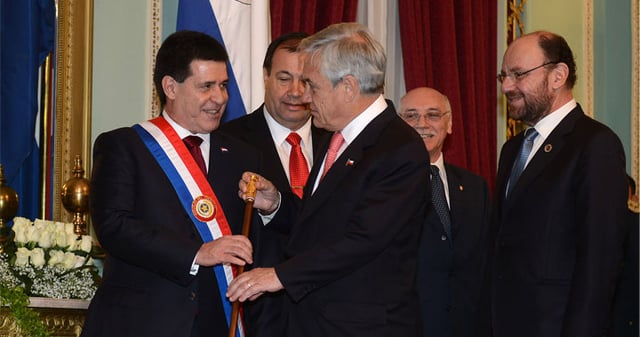
Inauguration of former President Horacio Cartes, 15 August 2013
For the 2008 general elections, the Colorado Party was favored in polls. Their candidate was Minister of Education Blanca Ovelar, the first woman to be nominated as a candidate for a major party in Paraguayan history. After sixty years of Colorado rule, voters chose Fernando Lugo, a former Roman Catholic Bishop and not a professional politician in civil government, and a member of the Authentic Radical Liberal Party, Paraguay's largest opposition party. Lugo was an adherent of liberation theology. Lugo achieved a historic victory in Paraguay's presidential election, defeating the ruling party candidate, and ending 61 years of conservative rule. Lugo won with nearly 41% of the vote, compared to almost 31% for Blanca Ovelar of the Colorado party.[46] Outgoing President Nicanor Duarte Frutos hailed the moment as the first time in the history of the nation that a government had transferred power to opposition forces in a constitutional and peaceful fashion.
Lugo was sworn in on 15 August 2008. The Lugo administration set its two major priorities as the reduction of corruption and economic inequality.[47]
Political instability following Lugo's election and disputes within his cabinet encouraged some renewal of popular support for the Colorado Party. Reports suggested that the businessman Horacio Cartes became the new political figure amid disputes. Despite the US Drug Enforcement Administration's strong accusations against Cartes related to drug trafficking, he continued to amass followers in the political arena.
On 14 January 2011, the Colorado Party convention nominated Horacio Cartes as the presidential candidate for the party. However, the party's constitution did not allow it. On 21 June 2012, impeachment proceedings against President Lugo began in the country's lower house, which was controlled by his opponents. Lugo was given less than twenty-four hours to prepare for the proceedings and only two hours in which to mount a defense.[48] Impeachment was quickly approved and the resulting trial in Paraguay's Senate, also controlled by the opposition, ended with the removal of Lugo from office and Vice President Federico Franco assuming the duties of president.[49] Lugo's rivals blamed him for the deaths of 17 people – eight police officers and nine farmers – in armed clashes after police were ambushed by armed peasants when enforcing an eviction order against rural trespassers.[50]
Lugo's supporters gathered outside Congress to protest the decision as a "politically motivated coup d'état".[49] Lugo's removal from office on 22 June 2012 is considered by UNASUR and other neighboring countries, especially those currently governed by leftist leaders, as a coup d'état.[51] However, the Organization of American States, which sent a mission to Paraguay to gather information, concluded that the impeachment process was not a coup d'état, as it had been carried out in accordance with the Constitution of Paraguay.[52]
Present day
From August 2013 to 15 August 2018, the President of Paraguay was Horacio Cartes. Since 15 August 2018, the current President of Paraguay is Mario Abdo Benítez.
Geography and climate
Geography

Paraguay map of Köppen climate classification
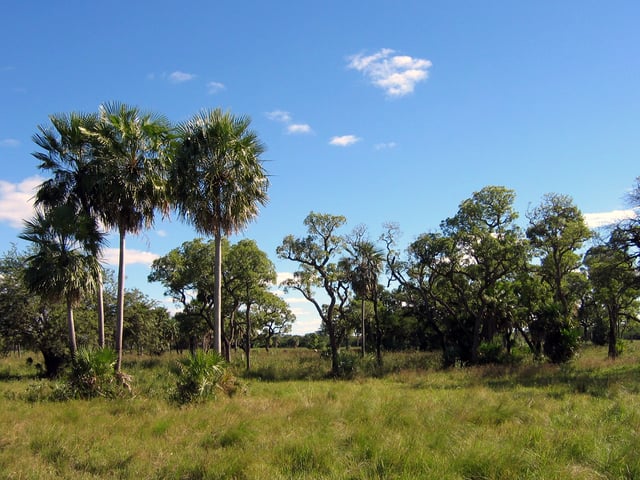
Landscape in the Gran Chaco, Paraguay
Paraguay is divided by the Río Paraguay into two well differentiated geographic regions. The eastern region (Región Oriental); and the western region, officially called Western Paraguay (Región Occidental) and also known as the Chaco, which is part of the Gran Chaco. The country lies between latitudes 19° and 28°S, and longitudes 54° and 63°W. The terrain consists mostly of grassy plains and wooded hills in the eastern region. To the west are mostly low, marshy plains.
Climate
The overall climate is tropical to subtropical. Like most lands in the region, Paraguay has only wet and dry periods. Winds play a major role in influencing Paraguay's weather: between October and March, warm winds blow from the Amazon Basin in the north, while the period between May and August brings cold winds from the Andes.
The absence of mountain ranges to provide a natural barrier allows winds to develop speeds as high as 161 km/h (100 mph). This also leads to significant changes in temperature within a short span of time; between April and September, temperatures will sometimes drop below freezing. January is the hottest summer month, with an average daily temperature of 28.9 degrees Celsius (84 degrees F).
Rainfall varies dramatically across the country, with substantial rainfall in the eastern portions, and semi-arid conditions in the far west. The far eastern forest belt receives an average of 170 centimeters (67 inches) of rain annually, while the western Chaco region typically averages no more than 50 cm (20 in) a year. The rains in the west tend to be irregular and evaporate quickly, contributing to the aridity of the area.
Government and politics
Paraguay is a representative democratic republic, with a multi-party system and separation of powers in three branches. Executive power is exercised solely by the President, who is head of state and head of government. Legislative power is vested in the two chambers of the National Congress. The judiciary is vested on tribunals and Courts of Civil Law and a nine-member Supreme Court of Justice, all of them independent of the executive and the legislature.
Military
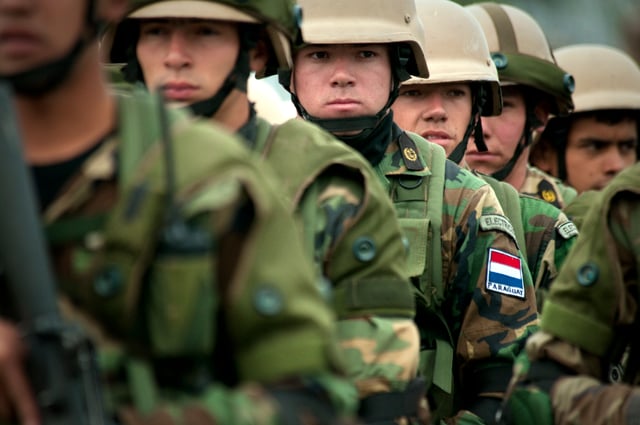
Paraguayan marines at Ancon Marine Base
The constitution of Paraguay (article 238) establishes the president of Paraguay as the commander-in-chief.[53]
Paraguay has compulsory military service, and all 18-year-old males and 17-year-olds in the year of their 18th birthday are liable for one year of active duty. Although the 1992 constitution allows for conscientious objection, no enabling legislation has yet been approved.
In 2017, Paraguay signed the UN treaty on the Prohibition of Nuclear Weapons.[56]
Administrative subdivisions
Paraguay consists of seventeen departments and one capital district (distrito capital).
It is also divided into two regions: The "Occidental Region" or Chaco (Boquerón, Alto Paraguay and Presidente Hayes), and the "Oriental Region" (the other departments and the capital district).
These are the departments, with their capitals, population, area and the number of districts:
| ISO 3166-2:PY | Departament | Capital | Population (2018 estimate) | Area (km²) | Districts |
|---|---|---|---|---|---|
| ASU | Distrito Capital | Asunción | 524,190 | 117 | 1 |
| 1 | Concepción | Concepción | 244,071 | 18,051 | 12 |
| 2 | San Pedro | San Pedro | 419,629 | 20,002 | 21 |
| 3 | Cordillera | Caacupé | 299,234 | 4,948 | 20 |
| 4 | Guairá | Villarrica | 220,818 | 3,846 | 18 |
| 5 | Caaguazú | Coronel Oviedo | 545,904 | 11,474 | 22 |
| 6 | Caazapá | Caazapá | 184,530 | 9,496 | 11 |
| 7 | Itapúa | Encarnación | 592,017 | 16,525 | 30 |
| 8 | Misiones | San Juan Bautista | 123,442 | 9,556 | 10 |
| 9 | Paraguarí | Paraguarí | 254,884 | 8,705 | 18 |
| 10 | Alto Paraná | Ciudad del Este | 796,689 | 14,895 | 22 |
| 11 | Central | Areguá | 2,072,041 | 2,465 | 19 |
| 12 | Ñeembucú | Pilar | 88,784 | 12,147 | 16 |
| 13 | Amambay | Pedro Juan Caballero | 164,462 | 12,933 | 5 |
| 14 | Canindeyú | Salto del Guairá | 221,647 | 14,667 | 14 |
| 15 | Presidente Hayes | Villa Hayes | 121,075 | 72,907 | 8 |
| 16 | Alto Paraguay | Fuerte Olimpo | 17,219 | 82,349 | 4 |
| 17 | Boquerón | Filadelfia | 63,011 | 91,669 | 3 |
| – | Paraguay | Asunción | 7,052,983 | 406,752 | 254 |
The departments are further divided into districts (distritos).
Economy
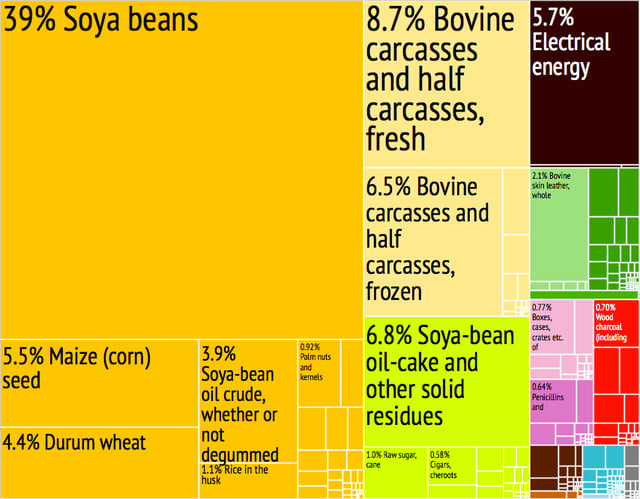
Graphical depiction of Paraguay's product exports in 28 color-coded categories, 2012
Between 1970 and 2013, the country had the highest economic growth of South America, with an average rate of 7.2% per year. In 2010 and 2013, Paraguay experienced the greatest economic expansion of South America, with a GDP growth rate of 14.5% and 13.6% respectively.[57]
In 2005 the International Monetary Fund explained that less than 10% of workers in Paraguay participate in the pension system, 95% of which is administered by two institutions. Both are financed on a pay as you go system by worker contributions; the first, Instituto de Previsión Social is for private sector employees, and the caja fiscal for public employees (including university professors, teachers, judicial employees, army officers and police officers) and veterans of the Chaco War (or their descendants).[58]
100% of Paraguay's electricity is produced using hydroelectricity, making it one of the cleanest in the world. Paraguay has an installed electrical production capacity of 8,110 MW, producing 63 billion kWh/year in 2016; with domestic consumption of just 15 billion kWh, the excess production is sold to Brazil, Argentina, and Uruguay, making Paraguay the world's largest exporter of electric power.[59] This production is from two large hydroelectric power projects along its borders, including the Itaipu Dam, the world's second largest generating station.
The market economy is distinguished by a large informal sector, featuring re-export of imported consumer goods to neighboring countries, as well as the activities of thousands of microenterprises and urban street vendors. Nonetheless, over the last 10 years the Paraguayan economy diversified dramatically, with the energy, auto parts and clothing industries leading the way.[61]
The country also boasts the third most important free commercial zone in the world: Ciudad del Este, trailing behind Miami and Hong Kong.[62] A large percentage of the population, especially in rural areas, derives its living from agricultural activity, often on a subsistence basis. Because of the importance of the informal sector, accurate economic measures are difficult to obtain. The economy grew rapidly between 2003 and 2013 as growing world demand for commodities combined with high prices and favorable weather to support Paraguay's commodity-based export expansion.
In 2012, Paraguay's government introduced the MERCOSUR (FOCEM) system in order to stimulate the economy and job growth through a partnership with both Brazil and Argentina.[63]
Industry and manufacturing
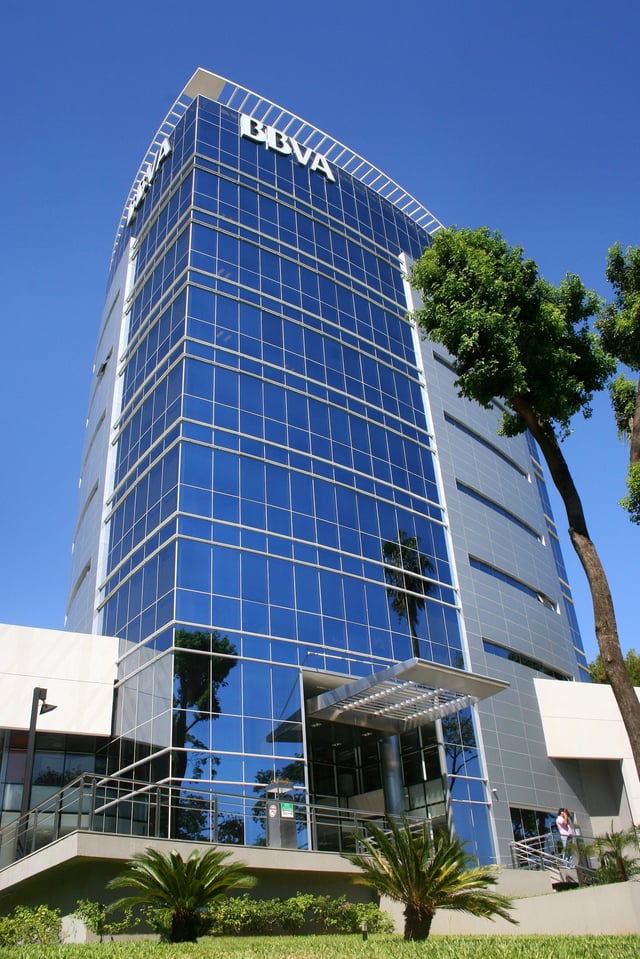
BBVA Paraguay
The mineral industry of Paraguay produces about 25% of the country's gross domestic product (GDP) and employs about 31% of the labor force. Production of cement, iron ore, and steel occurs commonly throughout Paraguay's industrial sector. The growth of the industry was further fueled by the maquila industry, with large industrial complexes located in the eastern part of the country. Paraguay put in place many incentives aimed to attract industries to the country. One of them is the so-called "Maquila law" by which companies can relocate to Paraguay, enjoying minimal tax rates.[64]
In the pharmaceutical industry, Paraguayan companies now meet 70% of domestic consumption and have begun to export drugs. Paraguay is quickly supplanting foreign suppliers in meeting the country's drug needs.[65] Strong growth also is evident in the production of edible oils, garments, organic sugar, meat processing, and steel.
In 2003 manufacturing made up 13.6% of the GDP, and the sector employed about 11% of the working population in 2000. Paraguay's primary manufacturing focus is on food and beverages. Wood products, paper products, hides and furs, and non-metallic mineral products also contribute to manufacturing totals. Steady growth in the manufacturing GDP during the 1990s (1.2% annually) laid the foundation for 2002 and 2003, when the annual growth rate rose to 2.5%.[66]
Social issues
Various poverty estimates suggest that 30–50% of the population is poor.[67] In rural areas, 41.20% of the people lack a monthly income to cover basic necessities, whereas in urban centers this figure is 27.6%. The top 10% of the population holds 43.8% of the national income, while the lowest 10% has 0.5%. The economic recession has worsened income inequality, notably in the rural areas, where the Gini coefficient has risen from 0.56 in 1995 to 0.66 in 1999.
More recent data (2009)[68] show that 35% of the Paraguayan population is poor, 19% of which live in extreme poverty. Moreover, 71% of the latter live in rural areas of the country.
Similarly, land concentration in the Paraguayan countryside is one of the highest in the globe: 10% of the population controls 66% of the land, while 30% of the rural people are landless.[69] In the immediate aftermath of the 1989 overthrow of Stroessner, some 19,000 rural families occupied hundreds of thousands of acres of unused lands formerly held by the dictator and his associates by mid-1990, but many rural poor remained landless. This inequality has caused a great deal of tensions between the landless and land owners.[45]
Social issues of the indigenous
Literacy rates are extremely low among Paraguay's indigenous population, who have an illiteracy rate of 51% compared to the 7.1% rate of the general population.[70]
Only 2.5% of Paraguay's indigenous population has access to clean drinking water and only 9.5% have electricity.[70]
Demographics
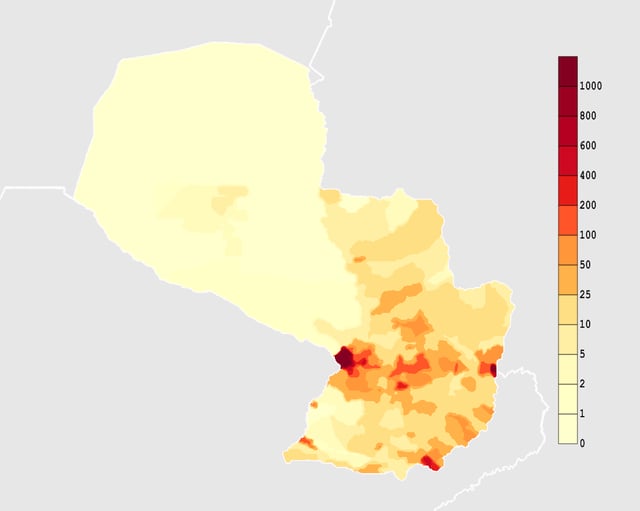
Paraguay population density (people per km2)
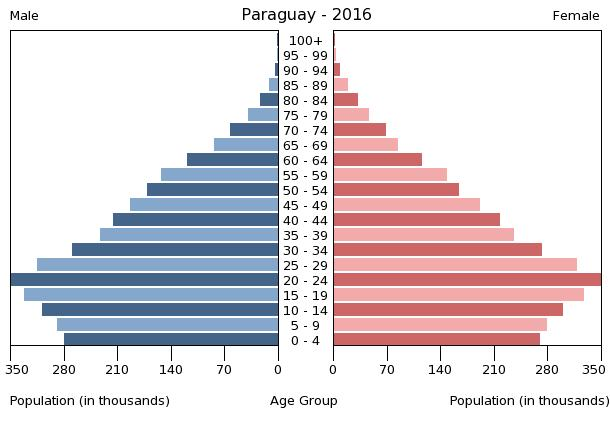
Population pyramid 2016
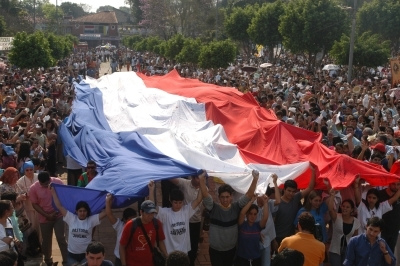
A gathering in Caacupé
| Population[71] | |||
|---|---|---|---|
| Year | Million | ||
| 1950 | 1.5 | ||
| 2000 | 5.3 | ||
| 2016 | 6.7 | ||
Paraguay's population is distributed unevenly through the country, with the vast majority of people living in the eastern region near the capital and largest city, Asunción, which accounts for 10% of the country's population. The Gran Chaco region, which includes the Alto Paraguay, Boquerón and Presidente Hayes Department, and accounts for about 60% of the territory, is home to less than 2% of the population. About 56% of Paraguayans live in urban areas, making Paraguay one of the least urbanized nations in South America.
For most of its history, Paraguay has been a recipient of immigrants, owing to its low population density, especially after the demographic collapse that resulted from the Paraguayan War. Small groups of ethnic Italians, Germans, Russians, Japanese, Koreans, Chinese, Arabs, Ukrainians, Poles, Jews, Brazilians, and Argentines have also settled in Paraguay. Around 40% of the total Paraguayan population has some Italian descent.[72] Paraguay has also been a haven for communities persecuted for the religious faith, like the Bruderhof who were forced to leave England in 1941 because of their pacifist beliefs.[73][74] Many of these communities have retained their languages and culture, particularly the Brazilians, who represent the largest and most prominent immigrant group, at around 400,000.[75] Many Brazilian Paraguayans are of German, Italian and Polish descent.[76] There are an estimated 63,000 Afro-Paraguayans, comprising 1% of the population.[77]
There is no official data on the ethnic composition of the Paraguayan population, as the Department of Statistics, Surveys and Censuses[78] of Paraguay does not ask about race and ethnicity in census surveys, although it does inquire about the indigenous population. According to the census of 2002, the indigenous people made up 1.7% of Paraguay's total population.[79]
Traditionally, the majority of the Paraguayan population is considered mixed (mestizo in Spanish). HLA-DRB1 polymorphism studies have shown genetic distances between Paraguayans and Spanish populations were closer than between Paraguayans and Guaranis. Altogether these results suggest the predominance of the Spanish genetics in the Paraguayan populations.[80] According to the 2017 revision of the World Population Prospects[71], Paraguay has a population of 6,725,308, 95% of which are Mestizo or white and 5% are labelled as "other", which includes members of indigenous tribal groups. They are divided into 17 distinct ethnolinguistic groupings, many of which are poorly documented. Paraguay has one of the most prominent German communities in South America, with some 25,000 German-speaking Mennonites living in the Paraguayan Chaco.[81] German settlers founded several towns as Hohenau, Filadelfia, Neuland, Obligado and Nueva Germania. Several websites that promote German immigration to Paraguay claim that 5–7% of the population is of German ancestry, including 150,000 people of German-Brazilian descent.[82][83][84][85][86]
Religion
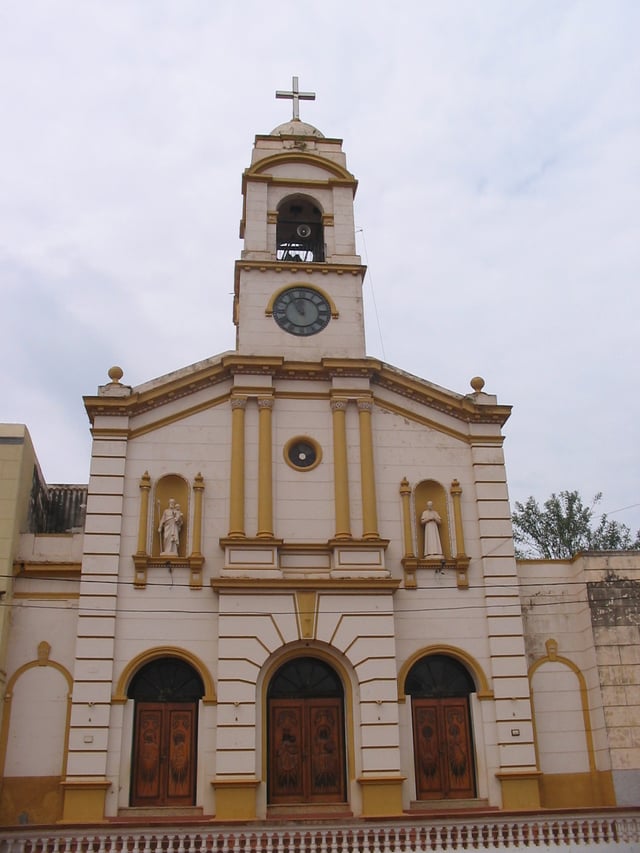
Main Catholic Chapel in Concepción, Paraguay
Christianity, particularly Roman Catholicism, is the dominant religion in Paraguay.[87] According to the 2002 census, 89.9% of the population was Catholic, 6.2% was Evangelical Protestant, 1.1% identified with other Christian sects, and 0.6% practiced indigenous religions. A U.S. State Department report on Religious Freedom names Roman Catholicism, evangelical Protestantism, mainline Protestantism, Judaism (Orthodox, Conservative, and Reform), Mormonism, and the Bahá'í Faith as prominent religious groups. It also mentions a large Muslim community in Alto Paraná (as a result of Middle-Eastern immigration, especially from Lebanon) and a prominent Mennonite community in Boquerón.[88]
Languages
Paraguay is a bilingual nation. Both Spanish and Guaraní are official languages. The Guaraní language is a remarkable trace of the indigenous Guaraní culture that has endured in Paraguay. Guaraní claims its place as one of the last surviving and thriving of South American indigenous national languages. In 2015, Spanish was spoken by about 87% of the population, while Guaraní is spoken by more than 90%, or slightly more than 5.8 million speakers. 52% of rural Paraguayans are bilingual in Guaraní. While Guaraní is still widely spoken, Spanish is generally given a preferential treatment in government, business, media and education as one of South America's lingua francas.[89][90][91][92]
Largest cities
Culture
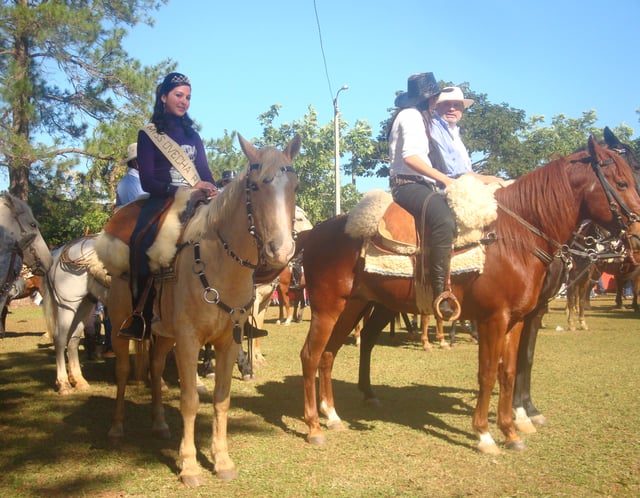
Ovecha Ragué Festival
Paraguay's cultural heritage can be traced to the extensive intermarriage between the original male Spanish settlers and indigenous Guaraní women. Their culture is highly influenced by various European countries, including Spain. Therefore, Paraguayan culture is a fusion of two cultures and traditions; one European, the other, Southern Guaraní. More than 93% of Paraguayans are mestizos, making Paraguay one of the most homogeneous countries in Latin America. A characteristic of this cultural fusion is the extensive bilingualism present to this day: more than 80% of Paraguayans speak both Spanish and the indigenous language, Guaraní. Jopara, a mixture of Guaraní and Spanish, is also widely spoken.
This cultural fusion is expressed in arts such as embroidery (ao po'í) and lace making (ñandutí). The music of Paraguay, which consists of lilting polkas, bouncy galopas, and languid guaranias is played on the native harp. Paraguay's culinary heritage is also deeply influenced by this cultural fusion. Several popular dishes contain manioc, a local staple crop similar to the yuca also known as Cassava root found in the Southwestern United States and Mexico, as well as other indigenous ingredients. A popular dish is sopa paraguaya, similar to a thick corn bread. Another notable food is chipa, a bagel-like bread made from cornmeal, manioc, and cheese. Many other dishes consist of different kinds of cheeses, onions, bell peppers, cottage cheese, cornmeal, milk, seasonings, butter, eggs and fresh corn kernels.
The 1950s and 1960s were the time of the birth of a new generation of Paraguayan novelists and poets such as José Ricardo Mazó, Roque Vallejos, and Nobel Prize nominee Augusto Roa Bastos. Several Paraguayan films have been made.
Inside the family, conservative values predominate. In lower classes, godparents have a special relationship to the family, since usually, they are chosen because of their favorable social position, in order to provide extra security for the children. Particular respect is owed them, in return for which the family can expect protection and patronage.[94]
Sports
Sport in Paraguay is an important part of the country's national culture. Football is the most popular sport, and basketball is also very popular.[95] Other sports such as volleyball, futsal, swimming and tennis are also popular.[95] Additional Paraguayan sports and pastimes include rugby union, chess, motorsport, golf and rowing.
Education
Literacy was about 93.6% and 87.7% of Paraguayans finish the 5th grade according to UNESCO's last Educational Development Index 2008. Literacy does not differ much by gender.[96] A more recent study[68] reveals that attendance at primary school by children between 6 and 12 years old is about 98%. Primary education is free and mandatory and takes nine years. Secondary education takes three years.[96] Main universities in Paraguay include:
National University of Asunción (public and founded in 1889)[97]
Autonomous University of Asunción (private and founded in 1979)[98]
Universidad Católica Nuestra Señora de la Asunción (private and run by the church).[99]
Universidad Americana (private).
Universidad del Pacífico (private and founded in 1991).
Health
Average life expectancy in Paraguay is rather high given its poverty: as of 2006, it was 75 years,[100] equivalent to far wealthier Argentina, and the 8th highest in the Americas according to World Health Organization. Public expenditure on health is 2.6% of GDP, while private health expenditure is 5.1%.[96] Infant mortality was 20 per 1,000 births in 2005.[96] Maternal mortality was 150 per 100,000 live births in 2000.[96] The World Bank has helped the Paraguayan government reduce the country's maternal and infant mortality. The Mother and Child Basic Health Insurance Project aimed to contribute to reducing mortality by increasing the use of selected life-saving services included in the country's Mother and Child Basic Health Insurance Program (MCBI) by women of child-bearing age, and children under age six in selected areas. To this end, the project also targeted improving the quality and efficiency of the health service network within certain areas, in addition to increasing the Ministry of Public Health and Social Welfare's (MSPBS) management.[101]
See also
Bibliography of Paraguay
Index of Paraguay-related articles
Outline of Paraguay
Israel-Paraguay relations
Foreign relations of Paraguay
![Seal [nb 1] of Paraguay](http://upload.wikimedia.org/wikipedia/commons/thumb/7/70/Coat_of_arms_of_Paraguay.svg/85px-Coat_of_arms_of_Paraguay.svg.png)